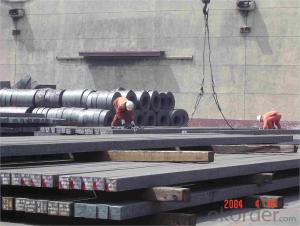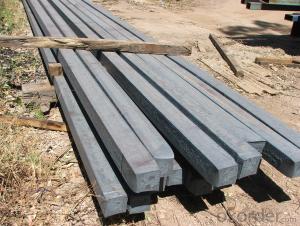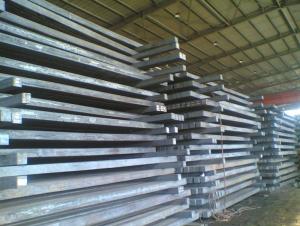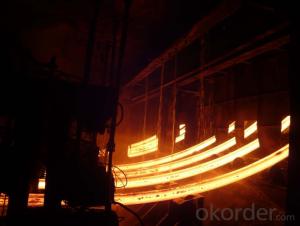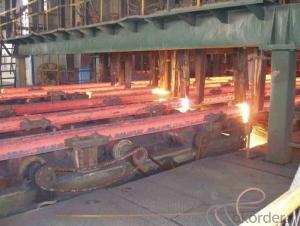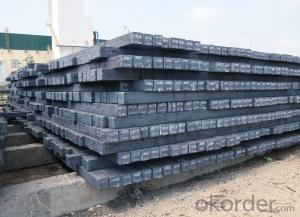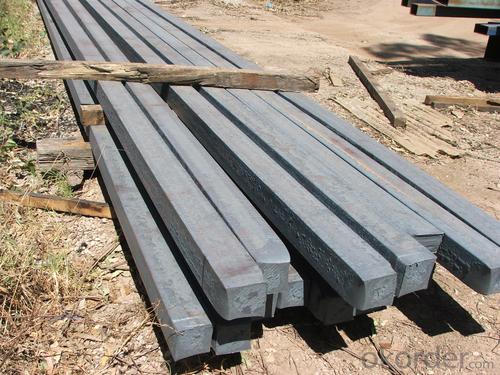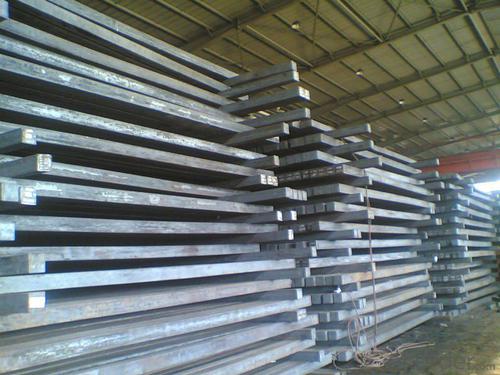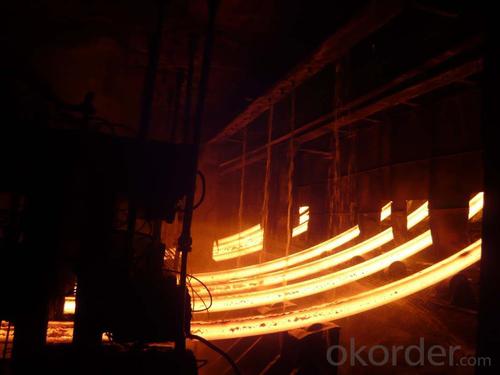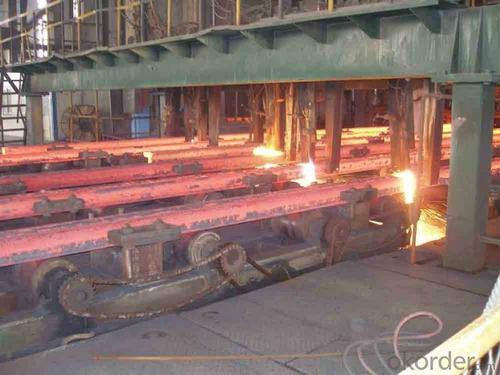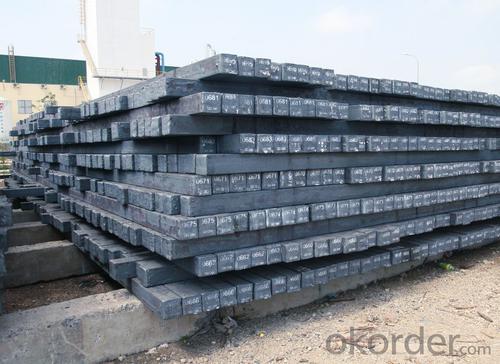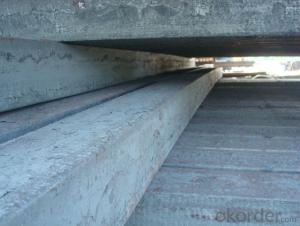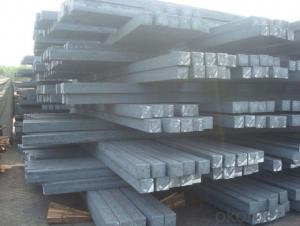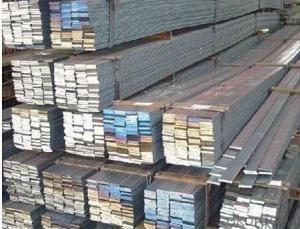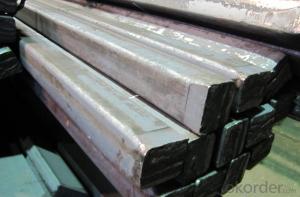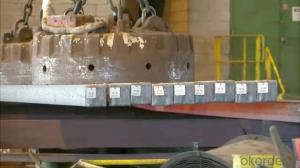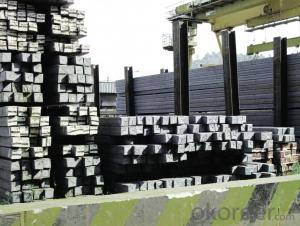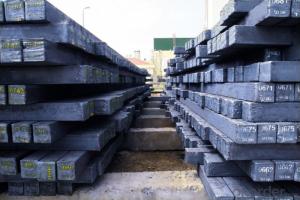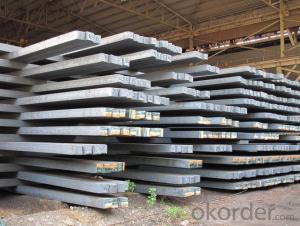Q235/3SP 185MM Blast Furnace Hot Rolled Steel Billet
- Loading Port:
- Tianjin
- Payment Terms:
- TT OR LC
- Min Order Qty:
- 2000 m.t.
- Supply Capability:
- 30000 m.t./month
OKorder Service Pledge
OKorder Financial Service
You Might Also Like
Description of Q235/3SP 185MM Blast Furnace Hot Rolled Steel Billet
Our hot dip galvanised steels consist of a steel substrate with a metallic zinc coating applied by means of a continuous hot dip galvanising process. Metallic zinc coatings are available in steel grades ranging from steel for bending and deep drawing applications, to structural steels and high yield strength steels.
A glossy surface finish obtained under specific skin-pass conditions (either non-skin-passed or skin- passed with smooth cylinders to obtain low roughness) can be provided if required at time of enquiry.
Advantage of Q235/3SP 185MM Blast Furnace Hot Rolled Steel Billet
Uncoated CR steel sheet With the features of in line with the international highest standards in demension and shape, excellent surface finish and properties, the products are mainly used in home appliance and automobile industries.
Galvanized steel sheet(include HDG and EG)
With the features of good corrosion resistance, the products are mainly used in automobile, home appliance, electronics, building and machinery manufacture industries, etc.
Precoated steel sheet With the features of enviromental protection and good processablility, long lasting surface durability, rich in colors, the products are maily used in building, home appliance and furniture industries, etc.
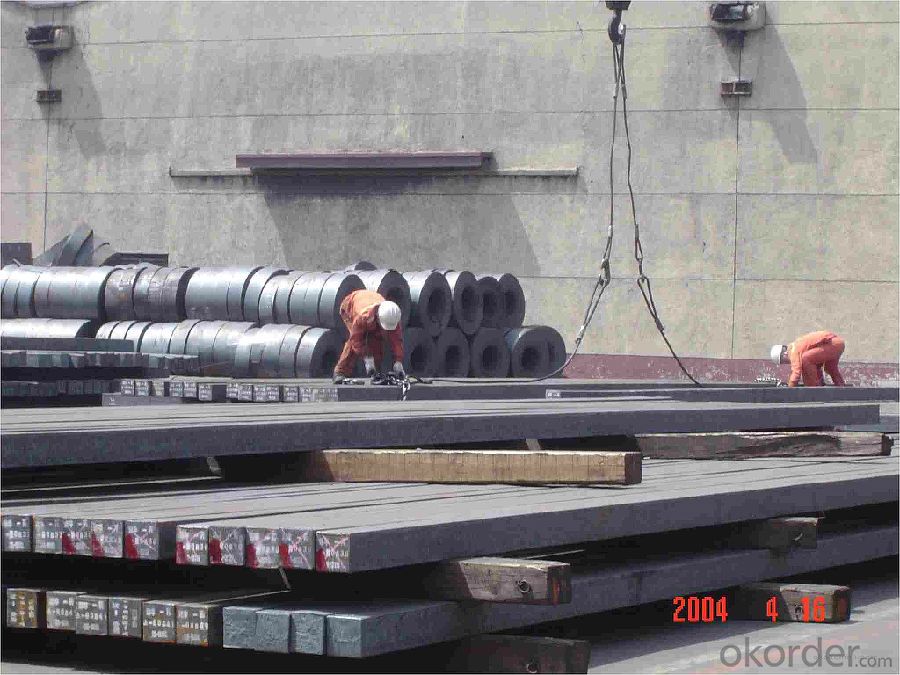
Applications of Q235/3SP 185MM Blast Furnace Hot Rolled Steel Billet
Our hot dip galvanised steels can be used in a very wide range of applications for industrial markets, both indoors and outdoors. Some of the most common applications are:
Building: wide sections for roofing and cladding, doors, door frames, metallic ceilings, partitions, structural members etc
Domestic appliances: all appliances for this sector (both white and brown goods) are manufactured with hot dip galvanised steels
Miscellaneous: electrical cabinets, aeraulic components, air conditioners, road signs etc
Zinc hot dip galvanised steel is suitable for contact with foodstuffs under certain conditions, as specified in European directive 89/109/EEC and French standard NF A 36-712-1. Please contact us for further information on this subject.
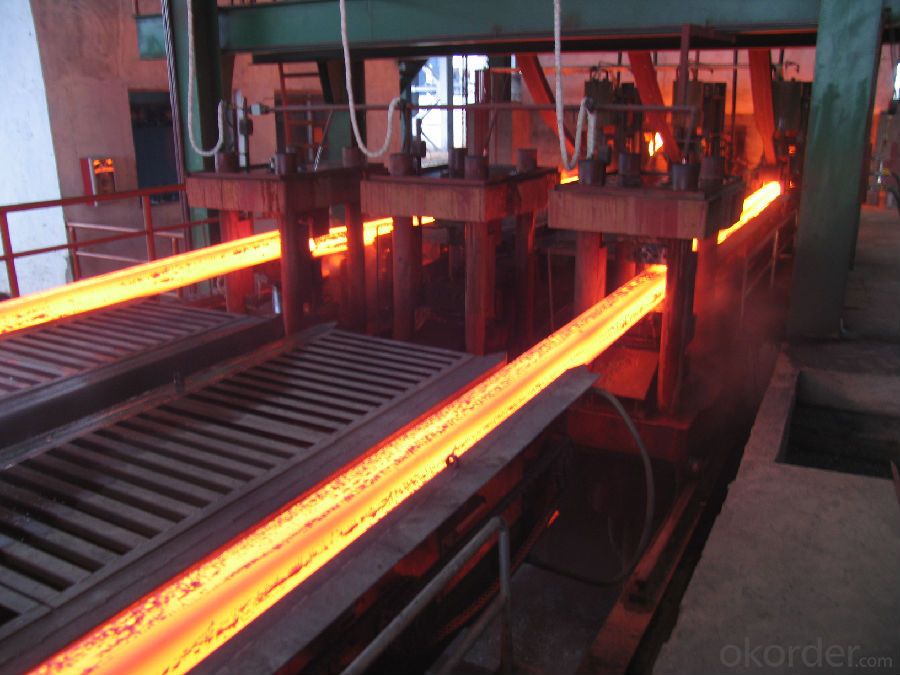
Specifications of Q235/3SP 185MM Blast Furnace Hot Rolled Steel Billet
Quality | Q/BQB 440-2003 | JIS G3312-1994 JIS G3321 | EN 10326-2004 | ASTM A653-02a |
EN 10327-2004 | (BASE PLATE) | |||
(BASE PLATE) | ||||
Commercial Steel | DC51D | SGCC SGLCC | DX51D+Z DX51D+AZ | CS Type A/B/C |
Forming Steel | St01,St02,St03 | SGCD1 SGLCD1 | FS Type A, Type B | |
Drawing | DC52D /DC53D | - | DX52D+Z DX52D+AZ | DDS TYPE A/C |
Steel | DX53D+Z DX53D+AZ | |||
Structural | S280GD (StE28) | SGC400 SGLC400 | S280D+Z DX54D+AZ | SS275 |
Steel | S350GD (StE34) | SGC440 SGLC440 | S350D+Z S350D+AZ | SS340 Class1 |
FAQ of Q235/3SP 185MM Blast Furnace Hot Rolled Steel Billet
We have organized several common questions for our clients,may help you sincerely:
1. How Can I Visit There?
Our company is located in Tianjin City, China, near Beijing. You can fly to Tianjin Airport Directly. All our clients, from home or aboard, are warmly welcome to visit us!
2. How Can I Get Some Sample?
We are honored to offer you sample.
3. Why choose CNBM?
Our delivery time about 15-20days for standard sizes, if you have other requirements like hardness, quanity and width ,it is about 20-40days. But don't worry we also try our best for the delivery time ,because time longer and our cost is higher.
- Q: What are the safety measures involved in handling steel billets?
- To ensure the well-being of workers and prevent accidents while handling steel billets, it is necessary to adhere to several important safety measures. These measures include the use of Personal Protective Equipment (PPE), proper training, regular equipment inspection, secure storage, adequate lighting, maintaining floor conditions, clear communication, and emergency preparedness. 1. Personal Protective Equipment (PPE): Workers must wear appropriate PPE, such as safety goggles, gloves, steel-toed boots, and helmets. This equipment provides protection against potential hazards like sharp edges, flying debris, and falling objects. 2. Training: Workers involved in handling steel billets should receive proper training on safe lifting techniques, handling procedures, and the use of equipment like cranes or forklifts. This knowledge helps minimize the risk of musculoskeletal injuries and accidents caused by improper handling. 3. Equipment Inspection: It is crucial to regularly inspect equipment like cranes, hoists, and lifting slings to ensure their proper functioning. Any defects or malfunctions should be promptly reported and repaired to prevent accidents. 4. Secure Storage: Steel billets should be stored securely and in an organized manner to prevent falls or tipping over. Proper racking systems and storage areas should be used to ensure stability and prevent accidents due to falling objects. 5. Adequate Lighting: Good lighting is essential in the working area to ensure clear visibility and prevent accidents caused by tripping or colliding with objects. 6. Floor Conditions: The floor should be kept clean and free from hazards such as oil spills or debris, which can cause slips, trips, or falls. Regular cleaning and maintenance are necessary to maintain a safe working environment. 7. Communication: Clear communication among workers involved in handling steel billets is crucial to prevent accidents. Coordination through signals, hand gestures, or the use of radios or other communication devices can help avoid collisions or accidents. 8. Emergency Preparedness: Adequate emergency preparedness measures, like fire extinguishers, first aid kits, and evacuation plans, should be in place. Workers should be trained in emergency procedures to ensure a swift and safe response in case of an incident. By following these safety measures, the risks associated with handling steel billets can be minimized, creating a safer work environment for all involved.
- Q: What are the different methods of surface treatment for steel billets?
- Various methods exist for surface treatment of steel billets, each serving a distinct purpose and offering unique advantages. Among the most commonly employed techniques are: 1. Pickling: This involves immersing the steel billets in an acid solution to eliminate surface impurities like rust or scale. Pickling enhances surface finish and readies the steel for subsequent treatment or processing. 2. Shot blasting: In this method, high-speed steel shots or grits are used to bombard the steel billets, eliminating surface contaminants and creating a uniform texture. Shot blasting is frequently employed to remove rust, scale, or paint, and it can enhance the adhesion of subsequent coatings or paints. 3. Galvanizing: This treatment entails coating the steel billets with a layer of zinc to provide corrosion resistance. Galvanizing can be accomplished through hot-dip galvanizing, where the steel is immersed in a molten zinc bath, or through electroplating, where a thin layer of zinc is deposited on the surface using an electric current. 4. Painting or powder coating: Steel billets can be painted or coated with powder to deliver both aesthetic appeal and protection against corrosion. Paints or powder coatings create a barrier between the steel surface and the environment, preventing moisture and other corrosive agents from reaching the metal. 5. Passivation: This method requires treating the steel billets with a chemical solution, typically an acid, to remove any free iron or iron oxide from the surface. Passivation enhances the corrosion resistance of stainless steel and other alloys by creating a passive oxide layer that safeguards against further oxidation or rusting. 6. Nitriding: Nitriding is a surface hardening treatment where the steel billets are exposed to an atmosphere rich in nitrogen at elevated temperatures. This process diffuses nitrogen into the steel's surface, forming a hardened layer that enhances wear resistance and improves fatigue strength. 7. Chrome plating: Steel billets can be coated with a layer of chromium through electroplating, providing enhanced corrosion resistance and a glossy appearance. Chrome plating is frequently utilized in applications where aesthetics and durability are crucial, such as automotive parts or decorative fixtures. These examples represent only a fraction of the available surface treatment methods for steel billets. The selection of a particular technique depends on factors such as the desired outcome, the specific properties required, and the intended application of the steel billets.
- Q: What are the different types of steel billet rolling processes?
- There are several types of steel billet rolling processes, including hot rolling, cold rolling, and warm rolling. Hot rolling involves heating the billet to a high temperature and then passing it through a series of rollers to shape it into the desired form. Cold rolling, on the other hand, is performed at room temperature and involves passing the billet through rollers to achieve a desired thickness or shape. Warm rolling is a combination of hot and cold rolling, where the billet is heated to a lower temperature compared to hot rolling but higher than room temperature. Each of these processes has its own advantages and is used for different applications in the steel industry.
- Q: What are the main factors affecting the machinability of alloy steel billets?
- Several key factors influence the machinability of alloy steel billets. Firstly, the machinability can be affected by the alloy composition of the steel. Different alloying elements, including chromium, nickel, molybdenum, and vanadium, have varying impacts on the machinability. Chromium and molybdenum, which form hard carbides, tend to decrease machinability, while nickel and vanadium, which promote the formation of softer carbides, can enhance machinability. Secondly, the heat treatment of the alloy steel billets significantly impacts machinability. Processes such as annealing, normalizing, or quenching and tempering can alter the microstructure and hardness of the steel. Proper heat treatment can improve machinability by reducing hardness and increasing toughness, while improper heat treatment can result in increased hardness and decreased machinability. Thirdly, the presence of impurities and inclusions in the alloy steel billets can affect machinability. Inclusions, such as sulfides, oxides, and non-metallic particles, can cause tool wear and chip breakability issues during machining. Therefore, the cleanliness and purity of the alloy steel billets are crucial factors in determining machinability. Furthermore, the mechanical properties of the alloy steel, such as hardness, strength, and ductility, can influence machinability. Higher hardness and strength levels can make machining more challenging, while increased ductility and toughness can improve machinability. Lastly, the cutting conditions and machining parameters, including cutting speed, feed rate, depth of cut, and tool material, also impact machinability. Optimal cutting conditions should be selected based on the specific alloy steel composition and desired machinability. Adequate cooling and lubrication during machining are also essential to reduce friction and heat, preventing tool wear and improving machinability. In conclusion, the machinability of alloy steel billets is influenced by factors such as alloy composition, heat treatment, impurities and inclusions, mechanical properties, and cutting conditions. Proper consideration of these factors can help optimize the machinability of alloy steel and ensure efficient and effective machining processes.
- Q: How are steel billets recycled at the end of their lifespan?
- Steel billets are recycled at the end of their lifespan through a process called steel scrap recycling. First, the billets are collected from various sources such as construction sites and manufacturing plants. They are then sorted, cleaned, and melted in a furnace to remove impurities. The molten steel is then cast into new billets or other steel products, ensuring that the steel billets are reused and not wasted, reducing the need for virgin steel production and conserving resources.
- Q: How are steel billets used in the production of railway infrastructure?
- Steel billets are an essential component in the production of railway infrastructure. These billets, which are semi-finished steel products, serve as the starting material for the manufacturing of various railway components such as rails, sleepers, and fasteners. To begin with, steel billets are first heated to a high temperature and then passed through a series of rollers to shape them into the desired profile. This process, known as hot rolling, ensures that the billets are transformed into long and narrow sections with a consistent cross-section. These sections serve as the foundation for the construction of railway tracks. One of the primary uses of steel billets in railway infrastructure is the production of rails. After the hot rolling process, the billets are further processed to form rails of various lengths and dimensions. These rails are then used to create the track structure, providing a stable platform for trains to run on. The high strength and durability of steel make it an ideal material for railway tracks, ensuring that they can withstand heavy loads and frequent traffic. Steel billets are also utilized in the production of sleepers, which are the horizontal supports that hold the rails in place. The billets are shaped and formed into concrete or wooden sleepers, which are then laid on the track bed to provide support and stability to the rails. These sleepers play a crucial role in distributing the weight of the trains and maintaining the alignment and gauge of the tracks. Additionally, steel billets are used in the manufacturing of fasteners such as bolts, nuts, and clips. These fasteners are essential for securing the rails to the sleepers and ensuring that they remain in position during train operations. The high strength and resilience of steel make it a reliable material for these critical components, as they need to withstand substantial stress and vibrations. In conclusion, steel billets play a vital role in the production of railway infrastructure. Their versatility and strength make them suitable for creating rails, sleepers, and fasteners, which are essential components of a reliable and robust railway system. Without the use of steel billets, the construction and maintenance of railway tracks would not be possible, ultimately impacting the efficiency and safety of train operations.
- Q: What are the different sizes of steel billets?
- Steel billets come in a variety of sizes, depending on their intended use and the specific requirements of the manufacturing process. The most common sizes of steel billets range from 100mm to 200mm square in cross-section. However, larger billets can also be produced, with sizes exceeding 300mm square. These larger billets are often used for heavy-duty applications or in industries that require larger quantities of steel, such as construction or shipbuilding. Additionally, steel billets can also be produced in round or rectangular shapes, depending on the requirements of the final product. The size of the steel billet is an important consideration in the manufacturing process, as it determines the amount of material that can be used and the level of precision that can be achieved during the shaping and forming processes.
- Q: What are the different methods used for heating steel billets?
- There are several different methods used for heating steel billets, depending on the specific requirements and constraints of the application. Some of the common methods include: 1. Induction Heating: This method uses electromagnetic induction to heat the steel billets. An alternating current is passed through a coil, creating a magnetic field that induces electrical currents in the billet, generating heat. Induction heating provides precise and controllable heating, allowing for uniform heating throughout the billet. 2. Gas Furnaces: Gas furnaces utilize burners to generate heat, which is then transferred to the steel billets through convection. Natural gas or propane is commonly used as the fuel source. Gas furnaces offer flexibility in terms of temperature control, heating rate, and energy efficiency. 3. Electric Resistance Heating: In this method, electric current is passed through resistive elements, such as heating elements or heating pads, that are in direct contact with the steel billets. The resistance to the electric current generates heat, which is transferred to the billets. Electric resistance heating is commonly used for smaller-scale operations or applications with specific heating requirements. 4. Flame Heating: Flame heating involves the use of an open flame, typically generated by a gas burner, to heat the steel billets. The billets are heated by the radiant heat emitted from the flame. Flame heating is often used for larger billets or in applications where rapid heating is required. 5. High-Frequency Heating: High-frequency heating utilizes electromagnetic fields to heat the billets. The billets are placed inside a coil, and a high-frequency alternating current is passed through the coil, inducing electrical currents in the billets. The resistance to the electrical currents generates heat, resulting in rapid and uniform heating. 6. Laser Heating: Laser heating involves the use of high-powered lasers to heat the steel billets. The laser beam is focused on the surface of the billet, generating intense heat through the absorption of the laser energy. Laser heating offers precise and localized heating, making it suitable for specific applications or for heat treating small areas of the billets. These are just a few of the methods commonly used for heating steel billets. The choice of method depends on factors such as the required heating rate, temperature control, energy efficiency, and the specific characteristics of the billets being heated.
- Q: How do steel billets contribute to the manufacturing of medical devices?
- The manufacturing of medical devices is greatly aided by steel billets in various ways. To begin with, steel billets act as the raw material for the production of medical devices. These billets serve as the starting point in the manufacturing process, where they undergo heating and shaping using techniques such as forging, casting, or rolling to achieve the desired form. The utilization of steel billets in the manufacturing of medical devices presents numerous advantages. Steel is renowned for its strength, durability, and resistance to corrosion, making it an ideal material for producing medical devices that must endure rigorous use and maintain their integrity over time. Additionally, steel possesses excellent biocompatibility, meaning it is well-tolerated by the human body, thereby reducing the risk of adverse reactions or complications when the medical devices are implanted or used in surgical procedures. Furthermore, steel billets can be easily machined and formed into intricate shapes, enabling manufacturers to create complex medical devices like orthopedic implants, surgical instruments, or prosthetic components. The versatility and malleability of steel allow for the production of devices with precise dimensions and intricate details, ensuring optimal functionality and performance. Moreover, steel billets contribute to the manufacturing of medical devices by providing a cost-effective solution. Steel is widely available and relatively affordable compared to other materials utilized in the medical industry. This affordability allows for the production of medical devices from steel billets at a reasonable cost, thereby enhancing the accessibility and affordability of healthcare worldwide. In conclusion, the role played by steel billets in the manufacturing of medical devices is of utmost importance. They serve as a sturdy, durable, and biocompatible material that can be easily shaped and machined into intricate forms. The properties of steel contribute to the creation of high-quality medical devices capable of withstanding demanding applications while ensuring patient safety and cost-effectiveness.
- Q: What are the different methods of steel billet cutting?
- There are several common methods for cutting steel billets, including sawing, shearing, abrasive cutting, and flame/plasma cutting. Sawing involves using a high-speed circular saw blade to cut through the billet, while shearing involves using a guillotine-like tool to apply a shearing force and cut the billet. Abrasive cutting utilizes a high-speed abrasive wheel to grind through the steel, and flame or plasma cutting involves using a focused flame or plasma arc to melt and cut the billet. Each method has its own advantages and disadvantages depending on the specific requirements of the project.
Send your message to us
Q235/3SP 185MM Blast Furnace Hot Rolled Steel Billet
- Loading Port:
- Tianjin
- Payment Terms:
- TT OR LC
- Min Order Qty:
- 2000 m.t.
- Supply Capability:
- 30000 m.t./month
OKorder Service Pledge
OKorder Financial Service
Similar products
Hot products
Hot Searches
Related keywords
